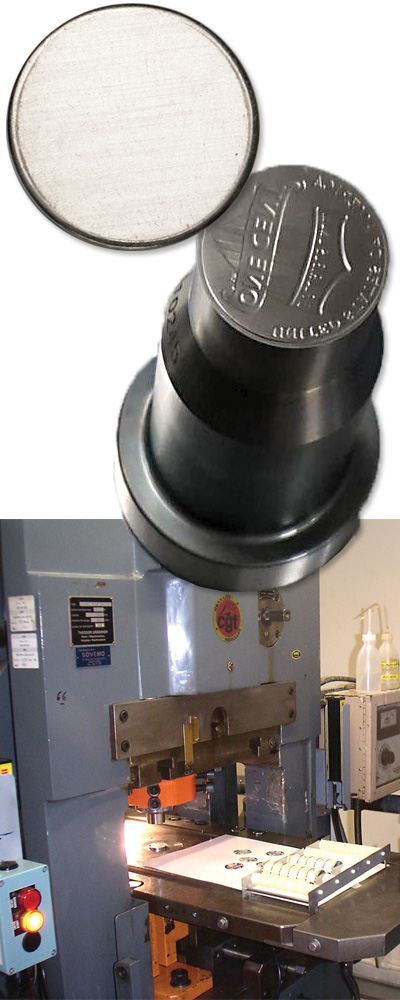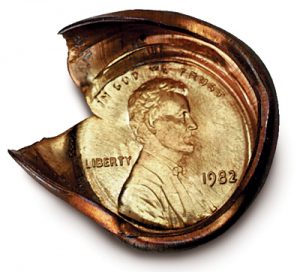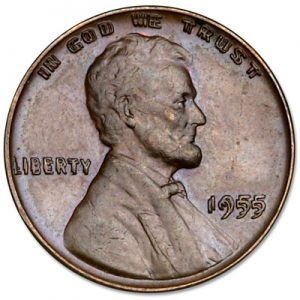Add drama to your collection with Error Coins!
Tips to get started
Each year the U.S. Mint strikes billions of perfect coins. So, who would want a “reject” when there are so many perfect ones available? Collectors do! Collectors eagerly search for error coins because they are visually dramatic, seldom available and many are unique one-of-a-kind mistakes. A single error is a prized possession, and two are the start of a collection – never before assembled, and different from any other. Sound interesting? All you need to get started is a sharp eye for a coin that looks a “little different,” a good light and magnifier.
In the early days of the U.S. Mint, errors and misstruck coins occurred frequently because much of the equipment was hand-operated and dates were punched by hand. Once the presses, collars and equipment became mechanized and automated, fewer errors happened.

A blank dime planchet above, Lincoln Shield cent reverse die, right.
Nowadays, tough quality control measures prevent “imperfectly” struck coins from ever leaving the Mint. Occasionally, errors do escape detection during the Mint’s inspection process and end up in coin bags. These coins are accidentally issued and eventually make their way to dealers and collectors.
Use Planchet/Die/Strike as your compass
One of the easiest ways to collect Errors is to remember PDS. In this case, the letters PDS don’t stand for Philadelphia, Denver and San Francisco – the U.S. Mints – but as a way to organize error coins. Error coins are grouped according to the PDS system, which stands for the three main production areas in the U.S. Mint where minting errors and varieties occur.
- P is for Planchets – the blank disc with a raised edge that is struck by two dies.
- D is for Dies – the piece of steel that has a mirror image of a coin design on it.
- S is for Strike – the flow of metal into the die’s design, creating the coin.
While the PDS system isn’t the only way to organize your collection, it does offer a method of arrangement that’s easy to understand.

This spectacular thimble-like error is dramatic and caused when a planchet sticks to the upper die and is repeatedly struck. It is called a Capped Die.
The difference between an Error and a Variety
As you delve into error coinage, you’ll soon discover that there are two very different groups – varieties and errors. Although the terms are sometimes used interchangeably, to the specialist, they have different meanings.
An error does not repeat exactly, it’s a random occurrence and no two are precisely alike, so each one is unique. This coin is created accidentally because of some malfunction in the minting process, such as a coin staying in the press when another enters, a piece of debris getting in the press, the die in the press breaking or any other random event.

The 1955 Doubled Die Obverse Lincoln cent was caused by a shift in the hub between impressions while making the obverse die. This popular error is dramatic and easy to see.
A variety repeats an identical engraving difference and it’s found on thousands of coins. Die varieties are coins struck with a die that has an engraving difference, problem or mistake. A doubled die coin is considered a variety.
Why not choose one error type that interests you for an Error Type Set? It makes an easy way to start your collection. So, you could get a clipped coin, an off-center strike, a broad strike and mated pair, etc. – just to name a few. Or another interesting set would be a blank planchet set, holding a blank planchet for each denomination struck for circulation.
Interesting Error coins give you a behind-the-scenes glance at the minting process and help you develop an appreciation for normally struck coins. Error coinage offers you a wide array of “mistakes” from those barely discernable to those that are dramatic and obvious – coins that even the non-collector will find fascinating. No matter how you choose to build yours, you’ll discover there are many fascinating errors out there displaying unusual characteristics, and all are just waiting to be found!




Just Google it ! Penny On Dime 1995. The most expensive/popular coinnerror doubled denomination and received highest offer on eBay auction of Seven Million US dollars.
do you look at coins and give an opinion i have come across an unusual penny .can not find another one with its errors. im new to coin collecting but this one is special
Hi Steve, we don’t grade coins for private parties, but we could certainly try and help you identify a coin. If you can send us some photos, we can have our Coin Graders take a look at your cent and let you know what they find. You can email your photos to: info@littletoncoin.com. Have a good day! -Rick
I have been looking for error coins for a few years now, but new to collecting . Just now begining to understand the wording used. After much reading and research. I have several I find to be different. I have not taken them to be looked at any where. I must say i am curious about them and ready to know what i have found and what they are. I am always looking thru change. Thank you for the error collecting advice.